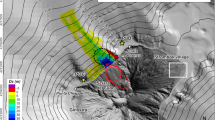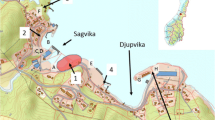Abstract
On February 6th, 1783, a landslide of about 5 × 106 m3 triggered by a 5.8 M earthquake occurred near the village of Scilla (Southern Calabria, Italy). The rock mass fell into the sea as a rock avalanche, producing a tsunami with a run-up as high as 16 m. The tsunami killed about 1,500 people, making it one of the most catastrophic tsunamis in Italian history. A combined landslide-tsunami simulation is proposed in this paper. It is based on an already performed reconstruction of the landslide, derived from subaerial and submarine investigation by means of geomorphological, geological and geomechanical surveys. The DAN3D model is used to simulate the landslide propagation both in the subaerial and in the submerged parts of the slope, while a simple linear shallow water model is applied for both tsunami generation and propagation. A satisfying back-analysis of the landslide propagation has been achieved in terms of run-out, areal distribution and thickness of the final deposit. Moreover, landslide velocities comparable to similar events reported in the literature are achieved. Output data from numerical simulation of the landslide are used as input parameters for tsunami modelling. It is worth noting that locations affected by recordable waves according to the simulation correspond to those ones recorded by historical documents. With regard to run-up heights a good agreement is achieved at some locations (Messina, Catona, Punta del Faro) between computed and real values, while in other places modelled heights are overestimated. The discrepancies, which were most significant at locations characterized by a very low slope gradient in the vicinity of the landslide, were probably caused by effects such as wave breaking, for which the adopted tsunami model does not account, as well as by uncertainties in the historical data.











Similar content being viewed by others
References
Baratta M (1901) I Terremoti d’Italia. Saggio di Storia, Geografia e Bibliografia Sismica Italiana, F.lli Bocca, Turin, Italy (in Italian)
Baratta M (1910) La catastrofe sismica calabro-messinese (28 dicembre 1908). Rend Soc Geogr It 496 (in Italian)
Boschi E, Guidoboni E, Ferrari G, Mariotti D, Valensise G, Gasperini P (2000) Catalogue of strong Italian earthquakes from 461 b.C. to 1997. Ann Geofis 43:609–868
Bosman A, Bozzano F, Chiocci FL, Mazzanti P (2006) The 1783 Scilla tsunami: evidences of a submarine landslide as a possibile (con?)cause. EGU 2006, Geophysical Research Abstracts, 8, p 10558
Bozzano F, Gaeta M, Martino S, Mazzanti P, Montagna A, Prestininzi A (2008) The 1783 Scilla rock avalanche (Calabria, Southern Italy). In: Chen Z, Zhang J, Li Z, Wu F, Ho K (eds) Proceeding of the 10th international symposium on landslides and engineered slopes, 30 June–4 July 2008, Xi’an (China), vol II. Taylor and Francis Group, London, pp 1381–1387
Bozzano F, Esposito E, Lenti L, Martino S, Montagna A, Paciello A, Porfido S (2010) Numerical modelling of earthquake-induced rock landslides: the 1783 Scilla case-history (Southern Italy). In: Fifth int. conf. on recent advances in earthquake engineering and soil dynamics, 24–29 May 2010, San Diego, California, Paper n.4.2b
De Lorenzo A (1877) Memorie da servire alla storia sacra e civile di Reggio e delle Calabrie, Cronache e Documenti inediti o rari, vol I, Reggio Calabria
Evans SG, Tutubalina OV, Drobyshev VN, Chernomorets SS, McDougall S, Petrakov DA, Hungr O (2009) Catastrophic detachment and high-velocity long-runout flow of Kolka Glacier, Caucasus Mountains, Russia in 2002. Geomorphology 105:314–321
Gerardi F, Barbano MS, De Martini PM, Pantosti D (2008) Discrimination of tsunami sources (Earthquake versus Landslide) on the basis of historical data in Eastern Sicily and Southern Calabria. Bull Seismol Soc Am 98(6):2795–2805
Graziani L, Maramai A, Tinti S (2006) A revision of the 1783–1784 Calabrian (southern Italy) tsunamis. Nat Hazards Earth Syst Sci 6:1053–1060
Hamilton W (1783) Relazione dell’ultimo terremoto delle Calabrie e delle Sicilia, sent by Hamilton SEG (trans: doctor Sella, G, Firenze)
Harbitz CB (1992) Model simulations of tsunamis generated by the Storegga slide. Mar Geol 105:1–21
Harbitz C, Pedersen G (1992) Model theory and large water waves, due to landslides. Preprint Series, 4, Department of Mathematics, University of Oslo
Harbitz CB, Pedersen G, Gjevik B (1993) Numerical simulations of large water waves due to landslides. J Hydraul Eng 119:1325–1342
Harbitz CB, Løvholt F, Pedersen G, Masson DG (2006) Mechanisms of tsunami generation by submarine landslides: a short review. Nor J Geol 86:255–264
Hungr O (1995) A model for the runout analysis of rapid flow slides, debris flows, and avalanches. Can Geotech J 32:610–623
Hungr O, Evans SG (1996) Rock avalanche runout prediction using a dynamic model. In: Senneset K (eds) Proc. 7th. international symposium on landslides, Trondheim, Norway, 1. pp 233–238
Hungr O, McDougall S (2009) Two numerical models for landslide dynamic analysis. Comput Geosci 35:978–992
Locat J, Lee HJ, Locat P, Imran J (2004) Numerical analysis of the mobility of the Palos Verdes debris avalanche, California, and its implication for the generation of tsunamis. Mar Geol 203:269–280
Løvholt F, Harbitz CB, Haugen KB (2005) A parametric study of tsunamis generated by submarine slides in the Ormen Lange/Storegga area off Norway. Mar Petroleum Geol 22:219–231
Mangeney A, Heinrich P, Roche R, Boudon G, Cheminée JL (2000) Modeling of debris avalanche and generated water waves: application to real and potential events in Montserrat. Phys Chem Earth 25(9–11):741–745
Mazzanti P (2008a) Studio integrato subaereo-subacqueo di frane in ambiente costiero: i casi di Scilla (RC) e del lago di Albano (RM). Giornale di Geologia Applicata 8(2):245–261
Mazzanti P (2008b) Analysis and modelling of coastal landslides and induced tsunamis. PhD Thesis “Sapienza” University of Rome, Department of Earth Sciences
Mazzanti P, Bozzano F (2009) An equivalent fluid/equivalent medium approach for the numerical simulation of coastal landslide’s propagation: theory and case studies. Nat Hazards Earth Syst Sci 9:1941–1952
Mazzanti P, Bozzano F, Avolio MV, Lupiano V, Di Gregorio S (2009) 3D numerical modelling of submerged and coastal landslides’ propagation. In: Mosher DC, Shipp C, Moscardelli L, Chaytor J, Baxter C, Lee H, Urgeles R (eds) Submarine mass movements and their consequences IV advances in natural and technological hazards research, vol 28. Springer, The Netherlands, pp 127–139
McDougall S, Hungr O (2004) A model for the analysis of rapid landslide motion across three-dimensional terrain. Can Geotech J 41:1084–1097
McDougall S, Boultbee N, Hungr O, Stead D, Schwab JW (2006) The Zymoetz River landslide, British Columbia, Canada: description and dynamic analysis of a rock slide–debris flow. Landslides 3:195–204
Mercalli G (1906) Alcuni risultati ottenuti dallo studio del terremoto calabrese dell’ 8 settembre 1905. Atti dell’Accademia Pontoniana di Napoli 36:1–9
Minasi G (1785) Continuazione ed appendice sopra i tremuoti descritti nella relazione 468 colla data di Scilla de 30 settembre 1783 con altro che accadde in progresso, 469 Messina
Minasi A (1970) La specola del filosofo, Natura e sorti nelle incisioni di Antonio Minasi, Ilario Principe, “Brutium”
Mohrig D, Whipple K, Ellis C, Parker G (1998) Hydroplaing of subaqueous debris flows. Geol Soc Am Bull 110:387–394
Monaghan JJ (1992) Smoothed particle hydrodynamics. Annu Rev Astron Astrophys 30:543–574
NGI (2008) Semi-annual report: tsunami impact in the outer part of Storfjorden, testing of numerical models for rock slide and tsunami, coupling to laboratory experiments. NGI report 20051018-2
Okal EA, Synolakis CE (2004) Source discriminants for near-field tsunamis. Geophys J Int 158:899–912
Pedersen G, Gjevik B (1983) Run-up of solitary waves. J Fluid Mech 135:283–299
Pirulli M, Mangeney A (2008) Results of back-analysis of the propagation of rock avalanches as a function of the assumed rheology. Rock Mech Rock Eng 41(1):59–84
Sarconi M (1784) Istoria de’ fenomeni del tremuoto avvenuto nelle Calabrie, e nel Valdemone nell’anno 1783. Reale Accademia delle Scienze, e delle Belle Lettere di Napoli, Napoli
Sosio R, Crosta GB, Hungr O (2008) Complete dynamic modelling calibration for the Thurwieser rock avalanche (Italian Central Alps). Eng Geol 100:11–26
Tinti S, Guidoboni E (1988) Revision of the tsunamis occurred in 1783 In Calabria and Sicily (Italy). Sci Tsunami Hazards 6(1):17–22
Tinti S, Maramai A, Graziani L (2004) The new catalogue of Italian tsunamis. Nat Hazards 33:439–465
Tinti S, Maramai A, Graziani L (2007) The Italian Tsunami Catalogue (ITC), Version 2. http://www.ingv.it/servizi-e-risorse/BD/catalogo-tsunami/catalogo-degli-tsunami-italiani
Vivenzio G (1788) Istoria de’ tremuoti avvenuti nella provincia di Calabria ulteriore e nella città di Messina nell’anno 1783, Napoli
Acknowledgments
A significant part of the work described in this paper was done while the first author was a guest researcher at the International Centre for Geohazards (Oslo, Norway). ICG–NGI researchers (Unni Eidsvig, Carl Harbitz, Sylfest Glimsdal and Finn Løvholt) performed the numerical modelling of the tsunami and they gave a fundamental support to the revision of the whole paper. Hence, their support is particularly acknowledged. Authors wish to thank Francesco Latino Chiocci and his research team for collecting submarine data and for the constant and fundamental support. A special thanks to the Guest Editor (A. Cattaneo) for the meticulous revision of the paper and the several comments which contributed to a significant improvement of the paper. This research was funded by the PRIN2006 Italian National project “Integration of inshore and offshore geological and geophysical innovative techniques for coastal landslides studies” (Principal Investigator: F.L. Chiocci), Research Unit: “The engineering-geology model as a tool for the dimensioning of gravity-induced coastal instabilities” (Associated Investigator: F. Bozzano).
Author information
Authors and Affiliations
Corresponding author
Rights and permissions
About this article
Cite this article
Mazzanti, P., Bozzano, F. Revisiting the February 6th 1783 Scilla (Calabria, Italy) landslide and tsunami by numerical simulation. Mar Geophys Res 32, 273–286 (2011). https://doi.org/10.1007/s11001-011-9117-1
Received:
Accepted:
Published:
Issue Date:
DOI: https://doi.org/10.1007/s11001-011-9117-1




